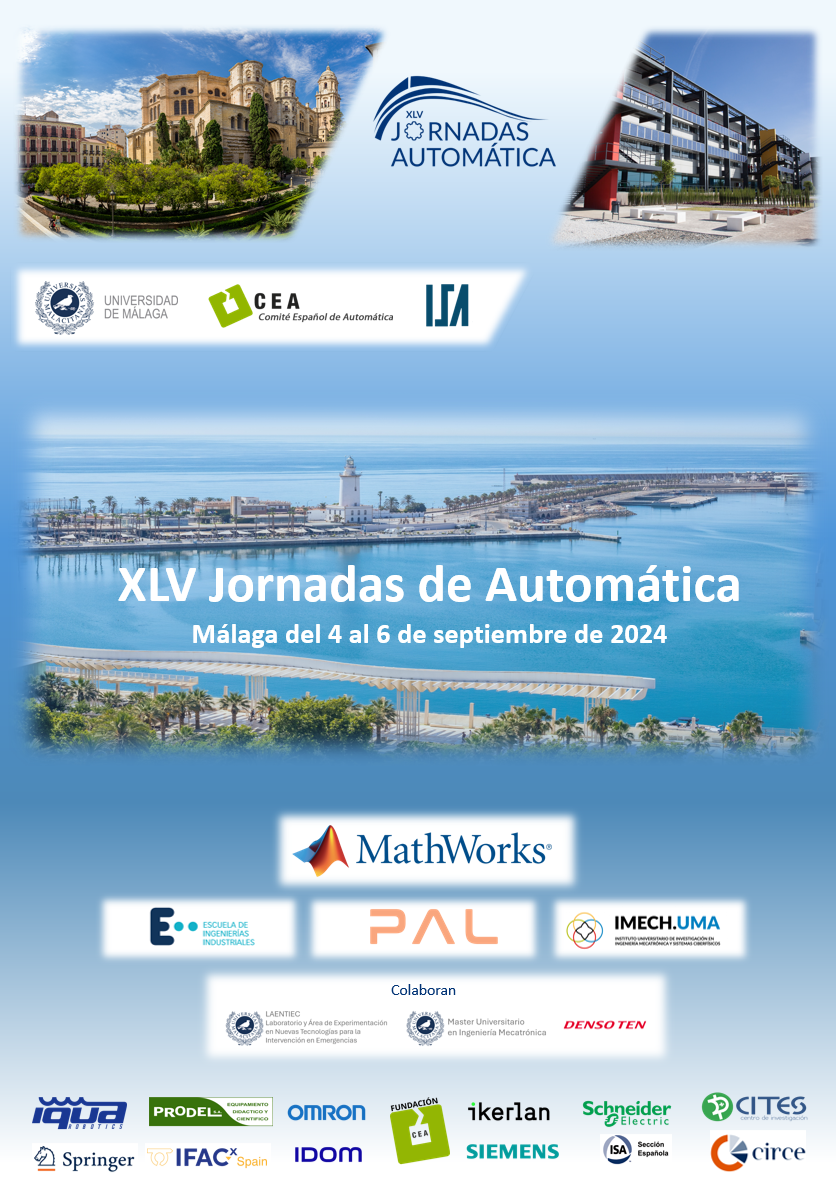Geodesic restricted aruco-based positioning for VR rehabilitation robotics
DOI:
https://doi.org/10.17979/ja-cea.2024.45.10964Palabras clave:
Trabajo en entornos reales y virtuales, Ingeniería de rehabilitación y prestación de servicios de salud, Percepción y sensado, Tecnología asistencial e ingeniería de rehabilitación, Manipuladores robóticos, Fusión de información y sensores, Computación centrada en el ser humano, Interfaces inteligentesResumen
La demanda de rehabilitación y terapia física en el mundo es cada vez mayor, debido a un envejecimiento de la población y a una vida más sedentaria. Una de las terapias más prometedoras es la terapia asistida con realidad virtual (VR), ya que mejora el ánimo del paciente, su autonomía y con ello las horas que le dedica a la terapia. Las carencias de este tipo de terapias surgen de no poder ofrecer ejercicios resistivos o con ayuda física al paciente. En el proyecto Roboasset hemos desarrollado un robot para simular ejercicios físicos en un entorno VR. Una problemática todavía no resuelta es conseguir la paridad de los elementos virtuales con los físicos. En este artículo desarrollamos un método para sincronizar los sistemas de coordenadas del robot físico con los del mundo virtual mediante el uso de marcadores fiduciarios (ArUco) y una cámara externa. Usando las propiedades geométricas de los cuaternios, conseguimos que la sincronización de los sistemas de coordenadas no introduzca ningún ruido en el ángulo del suelo.
Referencias
Bardorfer, A., Munih, M., Zupan, A., Primozic, A., Sep. 2001. Upper limb motion analysis using haptic interface. IEEE/ASME Transactions on Mechatronics 6 (3), 253–260. DOI: 10.1109/3516.951363
Barnett-Cowan, M., Barnett-Cowan, M., Harris, L. R., Harris, L. R., 2008. Perceived self-orientation in allocentric and egocentric space: effects of visual and physical tilt on saccadic and tactile measures. Brain Research. DOI: 10.1016/j.brainres.2008.0
Ceyte, H., Ceyte, H., Cian, C., Cian, C., Trousselard, M., Trousselard, M., Barraud, P., Barraud, P.-A., 2009. Influence of perceived egocentric coor- dinates on the subjective visual vertical. Neuroscience Letters. DOI: 10.1016/j.neulet.2009.06.048
Geest, S. D., Geest, S. D., Sabat ́e, E., Sabat ́e, E., Sabat ́e, E., 2003. Adherence to long-term therapies: Evidence for action:. European Journal of Cardio- vascular Nursing. DOI: 10.1016/s1474-5151(03)00091-4
Jiang, W., Jiang, W., Jiang, W., Yuan, X.-Z., Yuan, X., Yin, C., Yin, C., Wei, K., Wei, K., 2018. Visuomotor learning is dependent on direction-specific error saliency. Journal of Neurophysiology. DOI: 10.1152/jn.00787.2017
Kalaitzakis, M., Kalaitzakis, M., Cain, B., Cain, B., Carroll, S., Carroll, S., Ambrosi, A., Ambrosi, A., Whitehead, C., Whitehead, C., Vitzilaios, N., Vitzilaios, N. I., 2021. Fiducial markers for pose estimation. Journal of In- telligent and Robotic Systems. DOI: 10.1007/s10846-020-01307-9
Laver, K., Laver, K., George, S., George, S., Thomas, S., Thomas, S., Deutsch, J. E., Deutsch, J. E., Crotty, M., Crotty, M., 2015. Virtual re- ality for stroke rehabilitation. Cochrane Database of Systematic Reviews. DOI: 10.1002/14651858.cd008349.pub3
Lewis, G., Rosie, J., 04 2012. Virtual reality games for movement rehabilita- tion in neurological conditions: How do we meet the need and expectations of the users? Disability and rehabilitation 34, 1880–6. DOI: 10.3109/09638288.2012.670036
Michiels, N., Jorissen, L., Put, J., Liesenborgs, J., Vandebroeck, I., Joris, E., Reeth, F., 2024. Tracking and co-location of global point clouds for large- area indoor environments. Virtual Reality. DOI: 10.1007/s10055-024-01004-0
Reimer, D., Reimer, D., Podkosova, I., Podkosova, I., Scherzer, D., Scherzer, D., Kaufmann, H., Kaufmann, H., 2021. Colocation for slam-tracked vr headsets with hand tracking. The first computers. DOI: 10.3390/computers10050058
Steiner, B., Elgert, L., Saalfeld, B., Wolf, K.-H., Aug 2020. Gamification in rehabilitation of patients with musculoskeletal diseases of the shoulder: Scoping review. JMIR Serious Games 8 (3), e19914. URL: http://games.jmir.org/2020/3/e19914/ DOI: 10.2196/19914
Veerbeek, J. M., Veerbeek, J. M., Langbroek-Amersfoort, A. C., Langbroek- Amersfoort, A. C., van Wegen, E. E. H., van Wegen, E. E. H., Meskers, C. G., Meskers, C. G. M., Kwakkel, G., Kwakkel, G., 2017. Effects of robot-assisted therapy for the upper limb after stroke. Neurorehabilitation and Neural Repair. DOI: 10.1177/1545968316666957
Vogels, R., Vogels, R., Vogels, R., Orban, G. A., Orban, G. A., 1985. The effect of practice on the oblique effect in line orientation judgments. Vision Research. DOI: 10.1016/0042-6989(85)90140-3
Descargas
Publicado
Número
Sección
Licencia
Derechos de autor 2024 Ignacio Montesino Valle, Hugo Alonso Camara, Juan G. Victores, Carlos Balaguer, Alberto Jardon Huete

Esta obra está bajo una licencia internacional Creative Commons Atribución-NoComercial-CompartirIgual 4.0.





